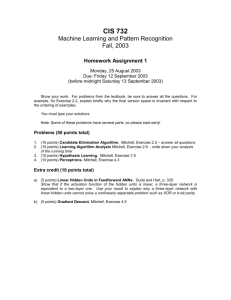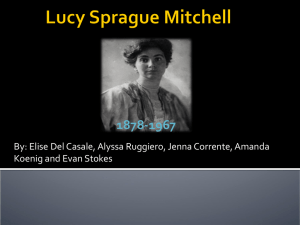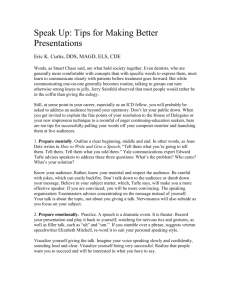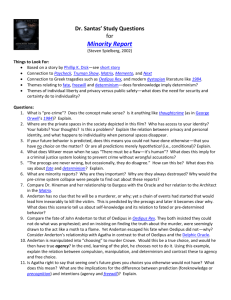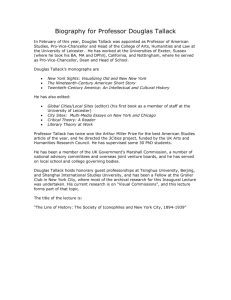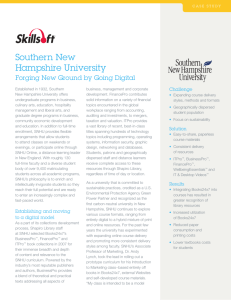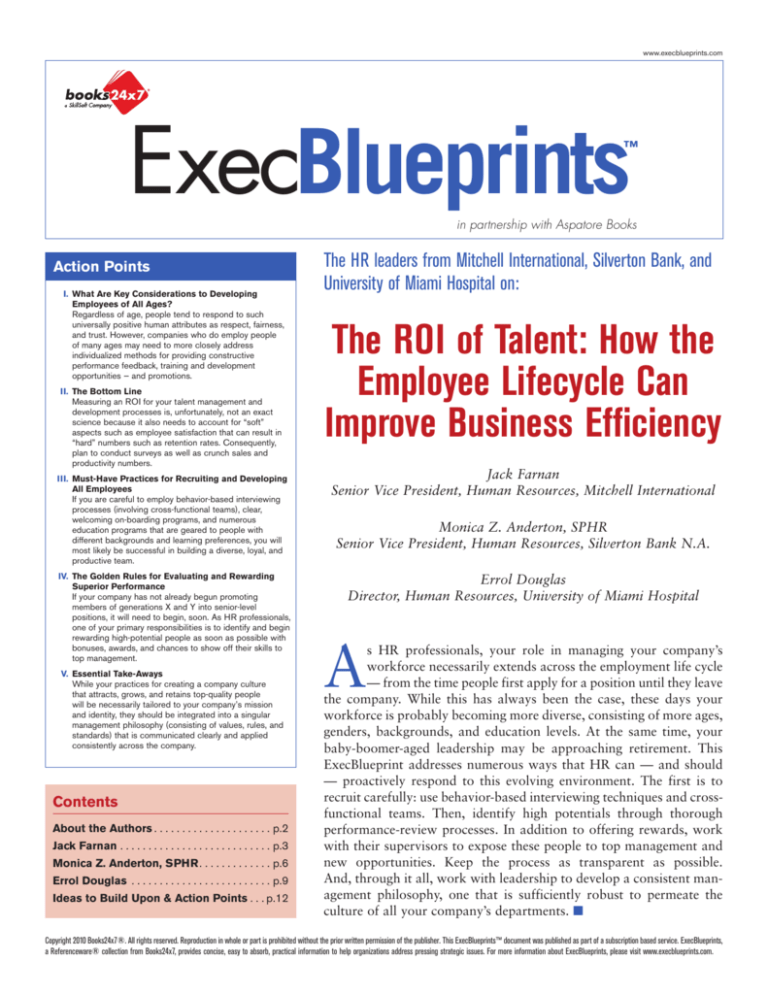
www.execblueprints.com
ExecBlueprints
™
in partnership with Aspatore Books
Action Points
I. What Are Key Considerations to Developing
Employees of All Ages?
Regardless of age, people tend to respond to such
universally positive human attributes as respect, fairness,
and trust. However, companies who do employ people
of many ages may need to more closely address
individualized methods for providing constructive
performance feedback, training and development
opportunities — and promotions.
II. The Bottom Line
Measuring an ROI for your talent management and
development processes is, unfortunately, not an exact
science because it also needs to account for “soft”
aspects such as employee satisfaction that can result in
“hard” numbers such as retention rates. Consequently,
plan to conduct surveys as well as crunch sales and
productivity numbers.
III. Must-Have Practices for Recruiting and Developing
All Employees
If you are careful to employ behavior-based interviewing
processes (involving cross-functional teams), clear,
welcoming on-boarding programs, and numerous
education programs that are geared to people with
different backgrounds and learning preferences, you will
most likely be successful in building a diverse, loyal, and
productive team.
IV. The Golden Rules for Evaluating and Rewarding
Superior Performance
If your company has not already begun promoting
members of generations X and Y into senior-level
positions, it will need to begin, soon. As HR professionals,
one of your primary responsibilities is to identify and begin
rewarding high-potential people as soon as possible with
bonuses, awards, and chances to show off their skills to
top management.
V. Essential Take-Aways
While your practices for creating a company culture
that attracts, grows, and retains top-quality people
will be necessarily tailored to your company’s mission
and identity, they should be integrated into a singular
management philosophy (consisting of values, rules, and
standards) that is communicated clearly and applied
consistently across the company.
Contents
About the Authors. . . . . . . . . . . . . . . . . . . . . . p.2
Jack Farnan. . . . . . . . . . . . . . . . . . . . . . . . . . . . p.3
Monica Z. Anderton, SPHR. . . . . . . . . . . . . . p.6
Errol Douglas . . . . . . . . . . . . . . . . . . . . . . . . . . p.9
Ideas to Build Upon & Action Points. . . p.12
The HR leaders from Mitchell International, Silverton Bank, and
University of Miami Hospital on:
The ROI of Talent: How the
Employee Lifecycle Can
Improve Business Efficiency
Jack Farnan
Senior Vice President, Human Resources, Mitchell International
Monica Z. Anderton, SPHR
Senior Vice President, Human Resources, Silverton Bank N.A.
Errol Douglas
Director, Human Resources, University of Miami Hospital
A
s HR professionals, your role in managing your company’s
workforce necessarily extends across the employment life cycle
— from the time people first apply for a position until they leave
the company. While this has always been the case, these days your
workforce is probably becoming more diverse, consisting of more ages,
genders, backgrounds, and education levels. At the same time, your
baby-boomer-aged leadership may be approaching retirement. This
ExecBlueprint addresses numerous ways that HR can — and should
— proactively respond to this evolving environment. The first is to
recruit carefully: use behavior-based interviewing techniques and crossfunctional teams. Then, identify high potentials through thorough
performance-review processes. In addition to offering rewards, work
with their supervisors to expose these people to top management and
new opportunities. Keep the process as transparent as possible.
And, through it all, work with leadership to develop a consistent management philosophy, one that is sufficiently robust to permeate the
culture of all your company’s departments. n
Copyright 2010 Books24x7®. All rights reserved. Reproduction in whole or part is prohibited without the prior written permission of the publisher. This ExecBlueprints™ document was published as part of a subscription based service. ­ExecBlueprints,
a Referenceware® collection from Books24x7, provides concise, easy to absorb, practical information to help organizations address pressing strategic issues. For more information about ExecBlueprints, please visit www.execblueprints.com.
About the Authors
Jack Farnan
J
Senior Vice President, Human Resources, Mitchell International
ack Farnan has over 25 years of
human resources experience in the
public and private sectors; in commercial and defense-oriented companies;
in large, medium, and small companies; in manufacturing and serviceoriented companies; and in national as
well as international firms. He is currently senior vice president of human
resources at Mitchell International, a
leading supplier of software for the automotive collision and casualty industry,
where he manages the human resources,
payroll, facilities, and physical security
functions.
Prior to joining Mitchell, Mr. Farnan
was vice president of human resources
at ComStream Corporation, a designer
and manufacturer of satellite-based telecommunications systems for the international marketplace. Before that he was
vice president of human resources at
ORINCON, a research and development
company specializing in digital signal
processing, artificial intelligence, and
neural networks.
Mr. Farnan is also currently an
instructor in the Human Resources
Leadership Program at the University of
California, San Diego (UCSD). He also
serves on the Human Resources Advisory
Committee of the Board of San Diego’s
Public Library System.
☛ Read Jack’s insights on Page 3
Monica Z. Anderton, SPHR
M
Senior Vice President, Human Resources, Silverton Bank N.A.
onica Z. Anderton is a certified
senior professional in human
resources with a track record
of successfully managing all aspects of
the corporate human resources function. She has in-depth experience in a
variety of diverse business environments
that include both union and non-union
settings for start-up high-tech, mature
telecommunications, retail, and banking
businesses.
In addition to being recognized across
the HR community for her voluntarism
and mentoring of young professionals,
Ms. Anderton has served as the president of the SHRM Atlanta mega chapter
and SHRM Georgia State Council. She
holds an M.B.A. from Mercer University
and participated in the University of
Michigan’s Human Resource Executive
Program.
☛ Read Monica’s insights on Page 6
Errol Douglas
E
rrol Douglas is a Jamaica native
who left the island in 1988 to
pursue his education and dreams
in the U.S. He has a passion for the
field of human resources, to which he
has contributed 15 years, and has a
wide range of generalist HR experience
including (but not limited to) employee
© Books24x7, 2010
Director, Human Resources, University of Miami Hospital
and labor relations, compensation, staff
training and development, recruitment,
and performance management.
Mr. Douglas holds an M.S. in business and industrial counseling and a B.S.
in human resources management from
Wright State University in Dayton, Ohio.
He has also been certified as a Senior
Professional in Human Resources from
the Society for Human Resource
Management (SHRM) since December
2002.
☛ Read Errol’s insights on Page 9
About the Authors ExecBlueprints Jack Farnan
Senior Vice President, Human Resources, Mitchell International
Management Best
Practices — the M3 Model
4. Mitchell values are integral to
our success.
The management practice implemented at our company that has
most helped bring out the best in
our employees and contributed to
corporate success is the Mitchell
Management Model, commonly
referred to as the “M3 Model.”
The company’s management philosophy embodies a singular yet
powerful concept. We expect that
all members of our management
team strive to be “Managers of
Choice.” This requires that each
manager do three things well — hire
the best, set clear expectations, and
create a great work environment.
To enable managers to achieve
this goal, we have developed a
comprehensive approach to managing an employee’s lifecycle while
they’re employed by Mitchell, starting with their initial days in the
company. To ensure consistency of
management practices across the
organization, Mitchell manager
needs to embrace this M3 Model.
In essence, the model embodies
four principles:
This model is implemented
through five components: recruiting, on-boarding, managing
performance, rewarding performance, and developing talent.
1. Mitchell is a performance
driven company.
2. Results matter, not just effort.
3. All colleagues are valued.
M3: Recruiting
The lifecycle begins with recruitment and the strategy is to “hire
the best, by using consistency and
rigor in the hiring process.”
Required tactics are to use a modified top grading process; behaviorbased interviewing; cross-functional
interview teams; interviews that are
focused on values and competencies; and, finally, roundtable
decision-making processes.
By requiring all hiring managers
to use this process, the company is
able to ensure that the absolute best
quality talent is brought into the
company. Since talented individuals
are an essential component of success, the M3 model demands a
rigorous, systematic recruiting
process.
M3: On-Boarding
Once the new employee begins
employment, it is important to
ensure that they assimilate as
quickly as possible into the work
What matters is that your organization has a
singular, consistent management philosophy,
carefully articulated to the management team
such that every department is being managed
with the same set of principles, using the same
standards and recognition strategies.
Jack Farnan
Senior Vice President, Human Resources
Mitchell International
© Books24x7, 2010
Jack Farnan
Senior Vice President, Human Resources
Mitchell International
“The reasons why employees leave
a company are lack of professional
growth, lack of skill development, or
lack of promotional opportunity — all of
which are related. Developing talent is
critical to retaining top talent.”
•Over 25 years of diverse HR experience
•Previously vice president of HR,
ComStream Corporation
•2008 recipient, “HR Professional of
the Year” Award in San Diego
•2009 recipient, “Human Resources
Lifetime Achievement Award”
Mr. Farnan can be e-mailed at
jack.farnan@execblueprints.com
environment so that they can attain
a “stickiness” that will keep them
engaged as well as assist them in
becoming productive as quickly as
possible. The on-boarding strategy
is to “Ensure new hire retention
through comprehensive assimilation actions.”
Required tactics are that all new
hires receive a corporate orientation; departmental orientation; a
buddy as part of a structured
buddy program; and performance
objectives. In addition, they must
complete an assimilation survey
Jack Farnan ExecBlueprints Jack Farnan
(continued)
Senior Vice President, Human Resources, Mitchell International
after their first 90 days. The new
employee, along with the manager
and buddy, all complete the survey.
Results are tabulated and reviewed
at the end of each quarter by the
SVP of HR with each respective
division general manager to ascertain whether or not there are any
problems in the new employee’s
assimilation process. The SVP then
reviews the results from all of the
divisions with the CEO, which
enables the CEO to do a quality
check on the company’s hiring and
on-boarding processes.
The concluding portion of the
on-boarding process is to conduct
a different survey with the new
hires after six months and then a
final assimilation survey at 12
months. The results of these surveys likewise are reviewed with the
Division GMs and the CEO.
M3: Managing Performance
The third component of the model
is managing performance. The
strategy is to “strive for high performance by providing timely and
frequent feedback to each
employee.” The tactics used are to
provide each employee with annual
performance reviews; mid-year performance reviews; self-evaluation
reviews; and peer reviews that
include upward appraisals (so
that employees can also grade their
managers).
Performance
management
focuses on two areas: what the
employee does and how they do it.
The “what” is basically their performance objectives or SMART
objectives: specific, measurable,
attainable, reasonable, and time
bound. These objectives flow down
from the overall corporate objectives and in this way each
© Books24x7, 2010
employee’s objectives are aligned
with the CEO’s. Consequently, all
management and employees are
focused on the same objectives to
ensure that the company’s goals are
attained.
The second part of the performance appraisal process is to grade
employees on “how” they get things
done. The “how” is focused on the
values of the company. It is not
enough for an employee to succeed
at meeting an objective — they
must also adhere to the company’s
values in accomplishing their ends.
If someone meets their performance
objectives but does so in a manner
that is orthogonal to our values, then
the employee has failed. By rating
employees on both of these factors,
it ensures that the company meets its
performance objectives as well as
holds employees responsible for demonstrating the values that contribute
to the corporate culture.
M3: Rewarding
Performance
The model’s fourth component is
rewarding performance. The strategy is to “pay for performance,
Managing by the Same Set of Principles:
The Mitchell Management Model”
The model’s four principles:
1. Mitchell is a performance driven company.
2. Results matter, not just effort.
3. All colleagues are valued.
4. Mitchell values are integral to success.
This model is implemented through five components:
1. Recruiting: “Hire the best, by using consistency and
rigor in the hiring process.”
2. On-boarding: “Ensure new hire retention through
comprehensive assimilation actions.”
3. Managing performance: “Strive for high performance
by providing timely and frequent feedback to each employees.”
4. Rewarding performance: “Pay for performance, differentiate
performance, and recognize and reward top performance.”
5. Developing talent: “Foster continuous improvement by providing
training opportunities for each employee to grow professionally.”
Jack Farnan ExecBlueprints Jack Farnan
Senior Vice President, Human Resources, Mitchell International
(continued)
Millennials entering the workforce have been recognized and rewarded from
birth more than any other generation in American history. Therefore it’s
important that a company’s recognition and reward programs reflect the
expectations of these new entrants to the workforce.
Jack Farnan
Senior Vice President, Human Resources
Mitchell International
differentiate performance, and recognize and reward top performance.” The tactics used are the
annual merit increase program;
utilization of spot cash awards;
quarterly department MVP awards;
annual corporate MVP awards; “I
Am Valued” awards; and “I Am
Easy To Do Business With” awards.
The combination of cash incentives
and peer recognition awards enables
the company to consistently recognize and reward top performers,
thereby reinforcing behavior and
performance that supports the
corporate vision.
© Books24x7, 2010
M3: Developing Talent
The fifth and last component of the
M3 Model is developing talent.
The strategy is to “foster continuous improvement by providing
training opportunities for each
employee to grow professionally.”
The tactics used are: an annual
development plan for every
employee; technical skills development for every employee; professional development through the
company’s in-house university;
education assistance via tuition
reimbursement; and a variety of
in-house management development
programs.
Creating a Management
Philosophy
While the key components in the
M3 Model work for us, they may
be different for other companies: it
really doesn’t matter what the components are. What matters is that
your organization has a singular,
consistent management philosophy,
carefully articulated to the management team such that every department is being managed with the
same set of principles, using
the same standards and recognition
strategies. By doing so, you will
bring out the best in every employee
in your company. n
Jack Farnan ExecBlueprints Monica Z. Anderton, SPHR
Senior Vice President, Human Resources, Silverton Bank N.A.
Current Demographics
Our employee average age is 35 to
45 with slight variations by job
function and department. For
instance, some of our clerical and
lower-level staff jobs are somewhat
younger due to the level of lower
skill sets needed for the function.
In addition, we also have some
recent college graduates that transitioned from intern to full-time
regular positions. Because we tend
to hire seasoned professionals, the
norm on the age front is between
30 to 45 years old. To me, age is
just a data point; I do not believe
it is any different than other types
of diversity, such as where you were
born, or what you like in your coffee — you simply have to have an
interchangeable platform that
ensures you meet the needs of
everybody.
Promoting Generations X
and Y
Generations X and Y are an integral part of our workforce; they
tend to be the next level down from
senior or, even, middle management, but they are mixed in. Most
of our senior-level positions, as a
matter of fact, are filled by very
young people who are just a couple
of years over the Gen X designation. While we will naturally see
that generational composition
change over time, sometimes I
wonder if our employee engagement and connectivity is high here
because the majority of our employees are close to the same age as our
senior team. Moreover, because a
lot of our X and Y folks have been
identified as high potential, they
are very much on the cusp of our
shrinking labor pool and consequently very high in our talent
base. We expect that they will move
into senior roles over the next
couple of years.
Because a lot of our senior team
is young, we do not experience
many barriers when preparing to
promote young people. We simply
follow the talent-management process: identify our high-potential
individuals, and make sure we
Monica Z. Anderton, SPHR
Senior Vice President, Human Resources
Silverton Bank N.A.
“We are big believers in open
communication and we push that
concept throughout the bank.”
•Certified senior professional in
human resources
•In-depth experience with HR
in start-up high tech, mature
telecommunications, retail, and
banking
•M.B.A., Mercer University
Ms. Anderton can be e-mailed at
monica.anderton@execblueprints.com
In terms of qualification demographics, we think that we are seeing more
individuals with advanced degrees and certifications related to financial
services, which is great because they join the institution with completed
advanced training that we do not need to provide. We like to see a mix
of education and experience from a variety of backgrounds. We have
been more and more successful at moving the company to think in a more
non-traditional manner, and people are starting to understand that you
do not have to be a banker to work at a bank. More specifically, you do
not have to be a bank salesperson to be a good salesperson at a bank. By
demonstrating that non-traditional employees can be successful here, we are
seeing a shift in the types of experience and expertise that we consider.
Monica Z. Anderton, SPHR
Senior Vice President, Human Resources
Silverton Bank N.A.
© Books24x7, 2010
Monica Z. Anderton, SPHR ExecBlueprints Monica Z. Anderton, SPHR
(continued)
Senior Vice President, Human Resources, Silverton Bank N.A.
Because communication is very important to us and because we are open
and forthright communicators about what is going on in the business and
how that affects our employees, the employees can better understand certain
aspects of the business.
Monica Z. Anderton, SPHR
Senior Vice President, Human Resources
Silverton Bank N.A.
discuss, “Here are the developmental challenges,” and “Here are the
developmental opportunities.” At
the same time, we are educating the
executive team about these highpotential individuals, their skill
sets, their accomplishments and the
impact they have had on the business. By knowing your people and
helping them to know each other,
the difficulties that may be inherent
in times of transition lessen. They
may be 20 years younger, but
they know what they can do and
what they bring, and it has nothing
to do with their age.
Best Practices for
Developing Employees
Everybody learns differently and
we are very cognizant of that; I do
not believe that differences in how
employees learn and develop are
strictly age-based. Some are visual
learners, others are oral learners.
Some listen differently, some are
interactive. We have become very
aware of these differences and have
tailored a lot of our development
programs to ensure the varied needs
of our adult learners are addressed.
We conduct online and interactive
training that involves online modules in an effort to make sure that
our training is user-friendly but
still meets all different audience
requirements.
© Books24x7, 2010
We do not, however, have a perfect methodology for calculating a
return on investment for employee
development. We do look at attrition, retention, and performance
reviews, but to be honest, I do not
know that we have that metric
nailed down yet. We also consistently hear from employees in the
exit interview process that our
commitment to employee develop-
ment is equal to companies 10
times our size.
Bringing Out the Best in the
Bank Employees
One of our management practices
is to be very open to feedback —
up, down, and across. For example,
we started monthly town hall meetings where the CEO picks a topic
The Talent: Silverton’s Best Practices
for Motivating Employees
Remain very open to feedback
— up, down, and across.
Apply generous customer-service
strategies to internal communications.
Engage people to serve customers and
give back to the community through
the “Power of Partnership” initiative.
Monica Z. Anderton, SPHR ExecBlueprints Monica Z. Anderton, SPHR
(continued)
Senior Vice President, Human Resources, Silverton Bank N.A.
and employees can ask questions.
That activity offers the right environment for the management team
to acquire new ideas to meet challenges as well as to respond to
questions about the status quo.
Because communication is very
important to us and because we are
open and forthright communicators about what is going on in the
business and how that affects our
employees, the employees can better understand certain aspects of
the business.
Another practice that brings out
the best in our employees is that,
because we are customer-servicecentric, the programs that we roll
© Books24x7, 2010
out in the bank must have some
kind of measurable impact on the
customers and add value to
the customer experience. We use an
employee survey as a tool to link
our open-door communication policy to customer service. Outstanding
statistics highlight our good external communications, which is a
distinguishing feature of our excellent customer service. We then try
to apply the practice of being open,
honest, and first-in-class with our
customers to how we communicate
effectively in-house, too.
We also created a unique marketing approach around our
mission, vision, and guiding
principles called the “Power of
Partnership” initiative. Launched
with employees and customers, it
focuses on employees, customers,
and giving back to the community.
We have become very focused on
how we are helping our communities and how we are helping our
banks to live in these communities
and serve customers; that has also
become a key part of the business.
The “Power of Partnership” is a
customer-facing practice that has
also become a very big tool for us
internally with employees, because
they are very engaged in those
efforts. n
Monica Z. Anderton, SPHR ExecBlueprints Errol Douglas
Directory, Human Resources, University of Miami Hospital
In order to help a good worker advance in our
organization, we try to get them involved in
committees and programs that will highlight their
skills to top management-level people.
Errol Douglas
Directory, Human Resources
University of Miami Hospital
Demographics and
Retention Rates of Hospital
Employees
Almost 20 percent of the employees
at our hospital are in the tenured
group — employees who have
remained in continuous employment for five years or greater. This
is likely to be true for the industry
as a whole, because most people
choose nursing or health care as a
calling, not just a job. For example,
at our recent employee recognition
banquet, we honored seven 40-year
employees — and those workers
are not retiring.
However, our turnover rate has
changed over the past five years,
and this reflects a change in our
retention rate as well, as those
areas are somewhat related. Following our hospital’s transition
from its affiliation with Cedars to
becoming part of the University of
Miami, we moved from being a
for-profit to a not-for-profit organization. As a part of the University
of Miami, we feel that we have to
maintain a high standard with
respect to the public’s perception of
the university, and that mindset has
required a shift in paradigm with
respect to retaining some of our
employees. As a result of this transition we saw a slight increase in
turnover, which was probably necessary to grow the business and
increase the service element of our
© Books24x7, 2010
organization. However, that turnover rate is now stabilizing; our
goal is to have a turnover rate of
less than 12 or 14 percent for the
year.
Best Practices for
Developing Workers
In order to develop our workers we
offer extensive training to all age
groups. For example, we recently
brought in a group of new graduate
nurses who are going through a
cohort-based training program.
They will then go into a preceptorship program that will provide
further training to help them
become more acclimated and confident in their jobs. This is a regimented training program in that
these nurses are not doing anything
other than what is prescribed by
the program.
We also offer several clinical
programs through the university’s
professional and training development office that target various job
classifications. Such programs are
typically developed largely in
response to a need to address specific areas. This simply means that
we will have a training program
designed specifically for nursing,
or respiratory therapists, rather
than taking the non-specific
route.
Errol Douglas
Directory, Human Resources
University of Miami Hospital
“We believe that the university has
done a lot to improve our working
environment; the capital investments it
has made help our employees feel that
they want to be here to witness future
developments, and be part of a worldclass organization.”
•15 years’ HR experience with
employee and labor relations,
compensation, staff training and
development, recruitment, and
performance management
•SHRM-certified Senior Professional
in Human Resources since 2002
•B.S., Human Resources
Management; M.S., Business and
Industrial Counseling, Wright State
University (Dayton, OH)
Mr. Douglas can be e-mailed at
errol.douglas@execblueprints.com
Preparing the Executive
Team for Promotions of
Younger Employees
One of the primary aspects of our
role as human resource professionals is to truly affect and be a part
of the total lifecycle of our organization’s employees, and that process starts with orientation. In
some cases my managers will tell
me, “This employee is not going to
Errol Douglas ExecBlueprints Errol Douglas
(continued)
Directory, Human Resources, University of Miami Hospital
Preparing the Executive Team for Promotion of Younger Employees
Begin with orientation
Allows managers to evaluate potential employees early
Get employees involved in relevant programs/committees
Demonstrates skills to top management
Give them a seat at the table
Provides the opportunity to be part of the problem-solving process
make it”; but in other cases I will
hear, “We have a future star here.”
In order to help a good worker
advance in our organization, we try
to get them involved in committees
and programs that will highlight
their skills to top management-level
people. It is important to get
younger employees a seat at the
table so that they can express them-
selves and be heard, and so that
they can be part of the problemsolving process. To that end, we
always try to include new employees in the decision-making model
to assist in the development of our
organization.
In addition, our various department directors are directly
responsible for their own employees’ development by providing or
requesting training; employee
development is not just driven by
HR or the organization’s senior
leaders. Employee development is
a team effort at our hospital,
because a lot of people are involved
in the process.
Both managers and HR people accompany employees on their rounds,
and in that process we become familiar with individual employees. In
the “rounding” process you get to see an employee in their own element,
and you can see their uncoached interactions with patients, coworkers,
or supervisors. In essence, you are able to walk in and observe a reallife situation, which enables you to make a mental note of the employee’s
performance. Later on there may be times when opportunities for committee
placements come up, and when those situations arise you may say, “What
about employee B?”
Errol Douglas
Directory, Human Resources
University of Miami Hospital
© Books24x7, 2010
Errol Douglas ExecBlueprints 10
Errol Douglas
Directory, Human Resources, University of Miami Hospital
Benchmarks for Integrating
New Employees into an
Organization
Our nurses go through an extremely
regimented, prescribed training
program, as previously noted,
where they are tested and retested.
Toward the end of that program we
seek their feedback in terms of
what we could do better. We ask
© Books24x7, 2010
whether the program was beneficial to them, and who we should
recognize for helping them with
their growth and development.
With respect to other health care
employees, we do not have a regimented training program, but we
do have orientation/“on-boarding”
processes to enable them to become
comfortable in the organization
(continued)
and their department. The difference in the level of training
regimentation between these two
groups is largely due to differences
in the discipline and skill sets
required for those positions, and
the more critical nature of nursing
responsibilities. n
Errol Douglas ExecBlueprints 11
Ideas to Build Upon & Action Points
I. What Are Key Considerations
to Developing Employees of All
Ages?
People of different generations often respond to
very similar management strategies and practices,
including open communication, learning and
growth opportunities, and fair performance
appraisals. Moreover, organizations actually
benefit from having a multigenerational staff
because not only do its members offer different
points of view and experience, they can also
help each other grow up and with the company.
When formulating talent-management strategies
for such a workforce, however, important areas
to explore are:
• How can you encourage your leaders and
supervisors to apply consistent
management strategies?
• How can you help the company recruit the
best quality talent?
• How much diversity (e.g., ages, experience,
education) should your company strive for?
• When hiring, how can you inspire your
leadership team to consider non-traditional
backgrounds?
• How can new hires be efficiently
assimilated into the company so that they
become productive as quickly as possible?
• What are optimal performance review
procedures for your workforce?
• What cost-cutting initiatives have
employees successfully implemented?
• What are performance reviews revealing
about productivity?
III. Must-Have Practices for
Recruiting and Developing All
Employees
Your company’s hiring and training approaches will
necessarily differ, depending on the requirements
for your various positions. However, companies
can make more successful hires and people at
all levels can become more motivated if the
company invests in well-reasoned recruitment and
development processes. Programs and initiatives
that have proven successful at the authors’
companies are:
For recruitment and on-boarding:
• Modified top grading processes
• Cross-functional interview teams
• Values-and-competencies interviews
• Roundtable decision-making processes
• Corporate and departmental orientations
• Structured “buddy” programs
• Clear performance objectives
• Assimilation surveys
• How is “top performance” defined at your
company? What are appropriate ways to
compensate and/or promote based on top
performance?
• Annual development plans for each
employee
• How can you improve your turnover rates?
For development:
• Regular performance reviews that focus on
specific, measurable, attainable,
reasonable, and time-bound goals, and
include self-evaluation components
• On-site observations of employees in the
process of performing their jobs
• Technical skills training (using both online
and live formats)
II. The Bottom Line
• Tuition reimbursement for related education
You may not have a perfect methodology for
calculating an ROI for employee development.
However, being in the “people business,” you
probably realize that, to truly evaluate the
success of your efforts, you should measure
progress in both directions: your employee’s value
to the organization, and the organization’s
value to the employee. Important indicators
include:
• Management development and diversity
programs
• What do employee satisfaction surveys
reveal about how effectively you are
assimilating and developing people?
IV. The Golden Rules for
Evaluating and Rewarding
Superior Performance
• How do top-line sales — and turnover rates
— compare with those of previous years?
© Books24x7, 2010
• Establishing individual and group goals as
measures for monitoring overall progress
• Providing annual merit increases as well as
spot cash awards
• Creating peer commendations, such as
“MVP” or “I Am Valued” awards
• Paying bonuses based on individual and
group performance, as well as the overall
success of the company
• Involving high-potential people in
committees and programs that will
highlight their skills to top management
• Behavior-based interviewing
• What are the best methods for growing
your employees’ skills and knowledge?
• How will you groom promising young
employees today so that they can be
prepared to take on leadership roles in the
future?
must continue to help managers identify high
potentials among their ranks, and groom them
for promotion. This means making sure that they
can articulate and address both the development
challenges and opportunities inherent in
all promising employees and provide these
employees with the appropriate opportunities at
the right times. Proactive strategies and practices
can include:
• Exposure to different departments,
assignments
• Regimented cohort programs for highly
regulated professions (e.g., nursing)
V. Essential Take-Aways
One of the primary functions of HR is to
participate at every stage in the lifecycle of
your organization’s employees, from the time
they first apply for a position until they leave
the company. While specific strategies for
managing talent across this broad timeframe
will vary by organization, HR departments must
ensure that their companies apply a singular,
consistent management philosophy across all its
departments. Examples of philosophies that help
bring out the best in employees are:
• Clear expectations that managers will
closely follow company guidelines for
recruiting, on-boarding, managing
performance, rewarding performance, and
developing talent
• Emphasis on company values, rules, and
expectations as demonstrated by a
performance-review process that also
appraises how employees achieved their
objectives
• Non-hierarchical structures that permit
information and needs to flow freely
throughout the organization
• Receptivity and willingness to act upon
any employee’s new ideas
• Collaboration and transparency among the
executive team that provides a model for
the rest of the organization
• Alignment between customer-service and
employee-management practices
• Engagement of employees in programs that
give back to the broader community n
Your organization needs to know where its
next leaders are coming from, which is why HR
Ideas to Build Upon & Action Points ExecBlueprints 12
Ideas to Build Upon & Action Points
(continued)
?
10 Key Questions and Discussion Points
What are the current age demographics of employees at your company? How do age ranges
differ by department and job function? How are they typical or atypical from that of other
2 companies in your industry?
1
1
3
2
1
4
3
1
2
5
1
4
2
3
1
6
2
5
3
4
2
7
3
1
6
4
5
3
8
4
2
5
7
1
6
4
9
5
3
6
8
2
7
5
10
6
4
1
9
7
3
8
6
5
7
2
4
10
8
1
9
7
6
8
3
9
5
2
10
8
9
7
4
6
10
3
9
10
8
5
7
4
10
9
6
8
5
10
7
9
6
8
10
7
What particular education, expertise, and experience do people of different ages offer your
company? How has this mix of education, expertise, and experience changed in the past five
years?
How do members of generations X and Y presently contribute to the workforce at your
company? What roles do they generally fill?
What is your company’s retention rate for all employees? How does this rate differ by
department and job function? How does it differ by employee age?
What are your best practices for developing workers of all ages at your company? How do you
measure the effectiveness of these practices?
In the next 12 months, how do you plan to prepare your executive team for promotions of
younger employees into their ranks? Why is this preparation necessary? What challenges do
you expect to face? How will differences in culture and management styles be reconciled?
How do you benchmark the effectiveness of your efforts to successfully integrate younger
workers into the company? What role do retention rates play in your calculations? Performance
reviews? Other companies’ track records with the same populations?
How do you calculate the ROI for developing all workers? In what ways do employees of
varying ages differ in the way they contribute to the company’s overall ROI? How do you
calculate the value of new management strategies you have introduced that are geared to a
particular generation of employee?
What are the top five management policies and practices that have helped bring out the best
in every worker at the company? What has HR’s role been in developing these policies and
10 practices?
9
9
8
10
How are you developing your workers of all ages at your offshore locations? What
characteristics do workers of particular ages share across all your sites? What characteristics
are different?
ExecBlueprints is a subscription-based offering from Books24x7, a SkillSoft Company. For more information on subscribing,
please visit www.books24x7.com.
© Books24x7, 2010
Ideas to Build Upon & Action Points ExecBlueprints 13

